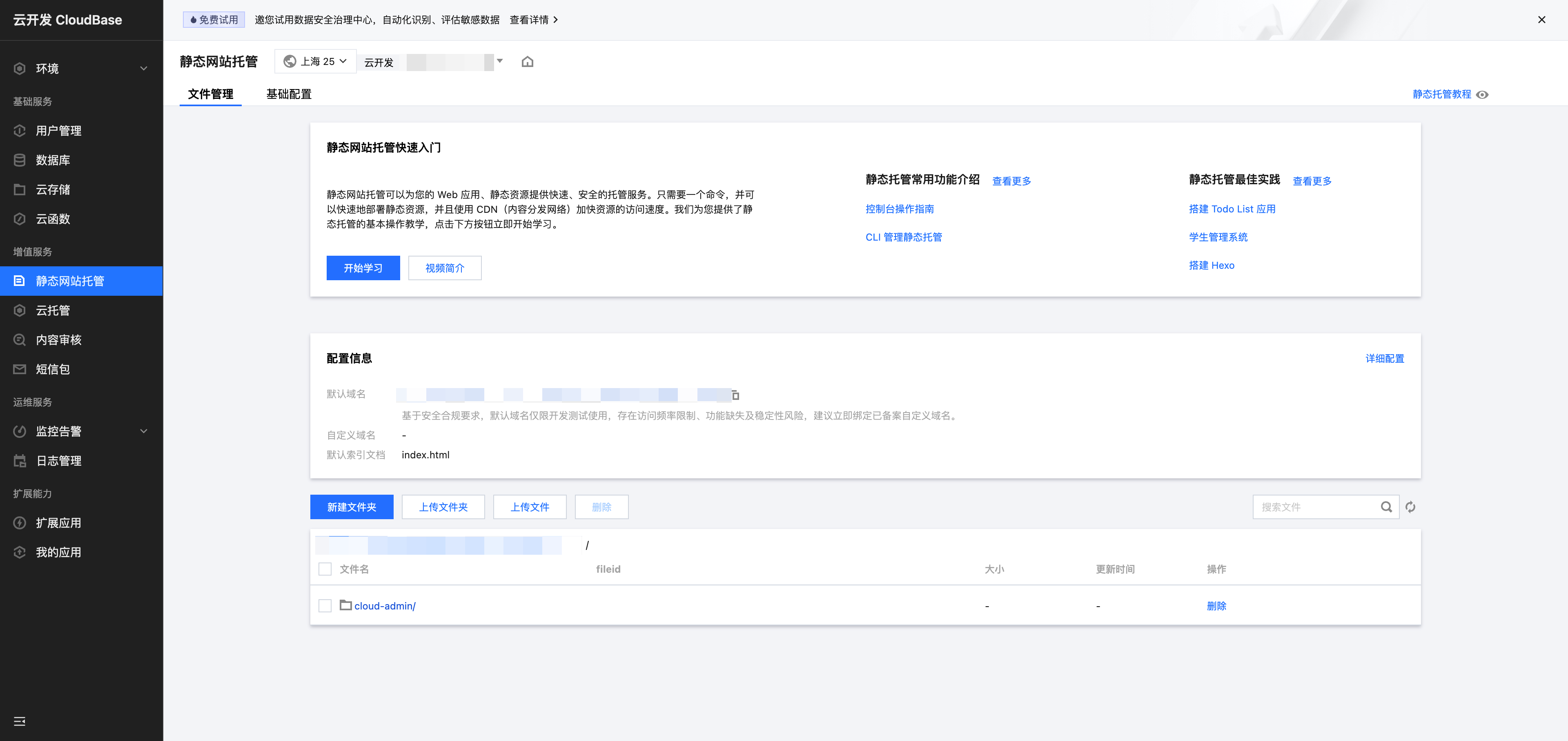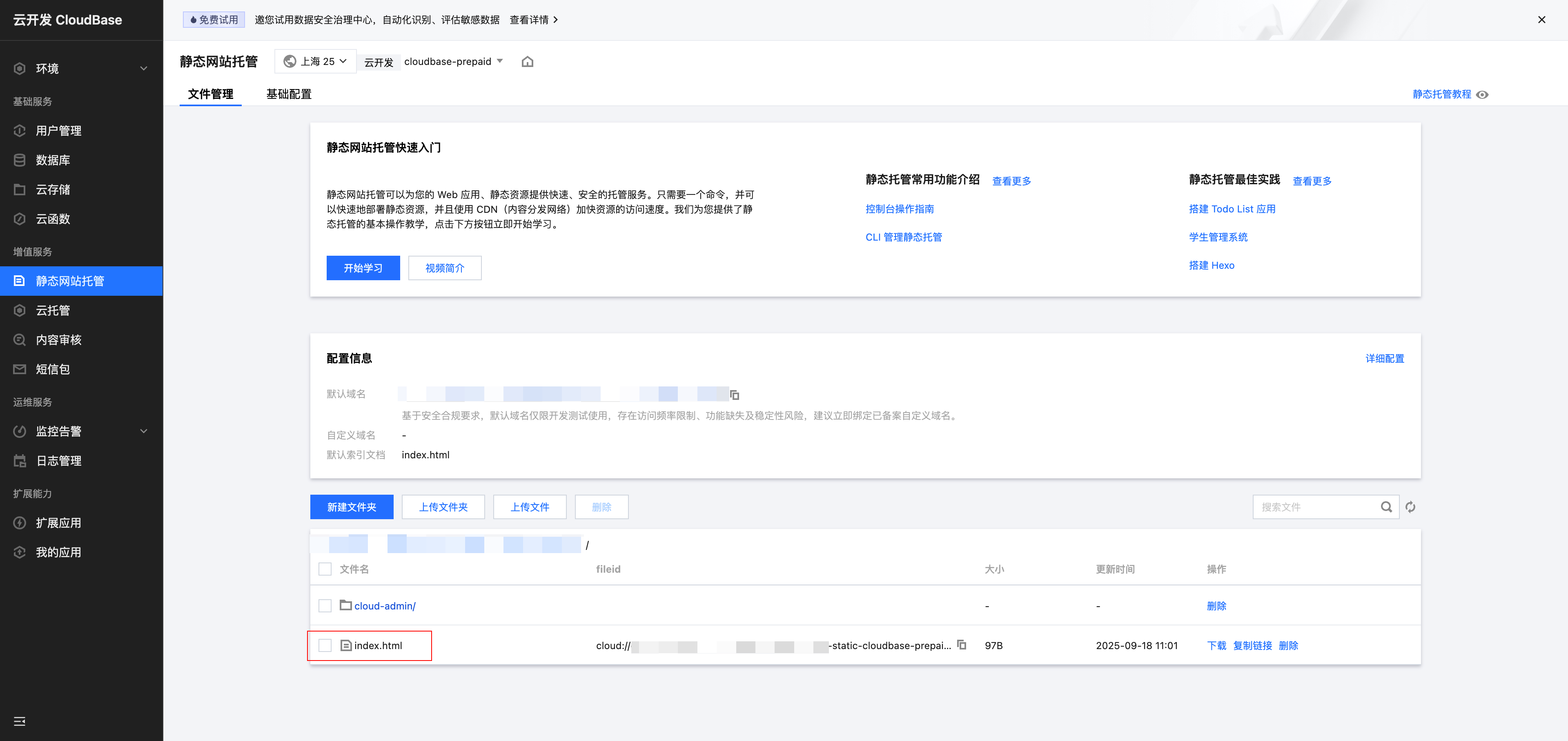Quick Start
This document guides you through getting started with CloudBase Static Website Hosting, allowing you to manage and deploy your static website files via the console.
Overview
CloudBase Static Website Hosting provides you with a convenient hosting service for static resources (HTML, CSS, JavaScript, images, etc.), supporting features such as custom domains, HTTPS, and CDN acceleration.
Prerequisites
Before you begin, ensure that you have:
- Have a Tencent Cloud account and complete real-name authentication
- You have created a Cloud Development environment
Step 1: Enable Static Website Hosting
- Go to CloudBase/Static Website Hosting
- Select your environment, click 'Static Website Hosting' in the left menu.
- Click the "Enable Static Website Hosting" button

- The initial activation process takes approximately 1-3 minutes
- After enabling, a default domain will be automatically assigned in the format:
env-id.xxx.tcloudbaseapp.com - For details such as the capacity of the Static Website Hosting service, please refer to Billing Instructions
Step 2: Prepare website files
Create a simple HTML file as an example, named index.html:
<!DOCTYPE html>
<html lang="zh-CN">
<head>
<meta charset="UTF-8">
<meta name="viewport" content="width=device-width, initial-scale=1.0">
<title>Welcome to CloudBase Static Website Hosting</title>
<style>
body {
font-family: -apple-system, BlinkMacSystemFont, 'Segoe UI', Roboto, sans-serif;
margin: 0;
padding: 40px;
background: linear-gradient(135deg, #667eea 0%, #764ba2 100%);
color: white;
text-align: center;
min-height: 100vh;
display: flex;
align-items: center;
justify-content: center;
flex-direction: column;
}
.container {
max-width: 600px;
}
h1 {
font-size: 2.5em;
margin-bottom: 20px;
}
p {
font-size: 1.2em;
line-height: 1.6;
margin-bottom: 30px;
}
.btn {
display: inline-block;
padding: 12px 24px;
background: rgba(255, 255, 255, 0.2);
border: 2px solid white;
border-radius: 25px;
color: white;
text-decoration: none;
transition: all 0.3s ease;
}
.btn:hover {
background: white;
color: #667eea;
}
</style>
</head>
<body>
<div class="container">
<h1>🎉 Congratulations!</h1>
<p>Your static website has been successfully deployed to the CloudBase platform</p>
<p>Now you can start building your website</p>
<a href="https://docs.cloudbase.net/" class="btn" target="_blank">View Documentation</a>
</div>
</body>
</html>
You can also prepare other types of files:
- CSS style files
- JavaScript script files
- Images, fonts, and other static resources
- Single Page Application (SPA) build artifacts
Step 3: Upload files
Method 1: Upload via console
- On the static website hosting page, click the "Upload File" button
- Select the prepared
index.htmlfile - Click [OK] to complete the upload

Method 2: Batch upload
If you have multiple files to upload:
- Click the "Upload Folder" button
- Select the entire folder containing the website files
- The system will preserve the original directory structure during the upload
- The size of a single file is limited to 50MB
- File names must not contain special characters. It is recommended to use English letters, digits, underscores, and hyphens.
- Uploading will overwrite files with the same name. Please proceed with caution.
Step 4: Access Your Website
Access Rules
The access link format for static resources is: default domain/file path
- Default Domain:
env-id.xxx.tcloudbaseapp.com - Default Index Document:
index.html
Access Example
Assuming your environment ID is my-env-123.xxx, the access link is as follows:
| File Path | Access Link | Description |
|---|---|---|
/index.html | https://my-env-123.xxx.tcloudbaseapp.com | Default page in the root directory |
/about/index.html | https://my-env-123.xxx.tcloudbaseapp.com/about | Default page in the subdirectory |
/css/style.css | https://my-env-123.xxx.tcloudbaseapp.com/css/style.css | CSS file |
/images/logo.png | https://my-env-123.xxx.tcloudbaseapp.com/images/logo.png | Image file |
Verify Deployment
- Copy your default domain name
- Open the link in the browser
- If you see the page content you uploaded, the deployment is successful

Next Steps
Congratulations! You have successfully deployed your first static website. Next, you can:
- Configure a custom domain - Use your own domain name to access the website